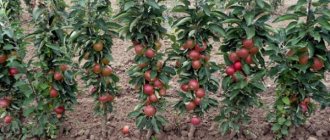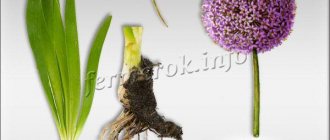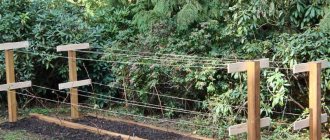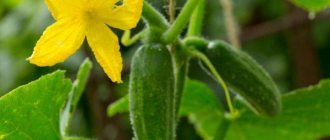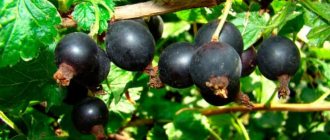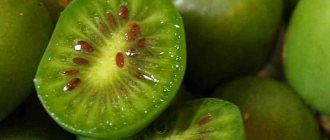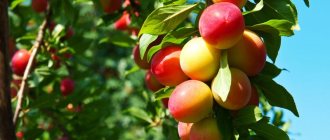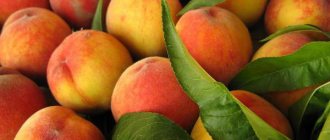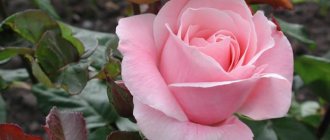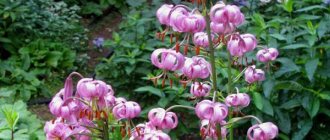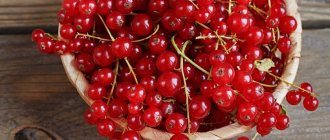Blackberries belong to the Rubus (raspberry) genus, which gives them some similarities with their fellow tribesman. It was bred in the USA in the century before last, and it was there that more than 150 of its varieties were cultivated. Americans have been growing and propagating blackberries for almost 200 years. In the middle zone and in the Moscow region, in particular, the plant appeared not so long ago. Planting and caring for it is very similar to working in a raspberry garden. Today we will introduce you to photos of the most popular varieties of our region, and will also try to highlight the main problems that a gardener may encounter on the way to a berry harvest.
Types and varieties of blackberries
At the moment, modern agronomists have bred more than 200 different types of blackberries. They can be grouped by the presence of thorns or by their growth pattern:
- Gray blackberry. It is also called ozhin or dewberry. It got its name due to the bluish waxy coating on the stems of the shoots. The main feature of this type of shrub is its growth form. The plant spreads along the ground, sometimes creating dense thickets. It is demanding of weather conditions and tolerates frosts without much joy. She definitely needs to build a shelter for the winter.
Gray blackberry - Nessa blackberry. Another name for her is bramble. The structure of its bush is very different from the previous species. The plant is upright. It has large dark purple spines. Tolerates low temperatures well. Doesn't need shelter.
Nessa blackberry
Among all the varieties bred by Russian and American breeders, only a few are suitable for Central Russia and the Moscow region. You can see the most popular of them in the photo below.
- Agawam . The variety, bred by American agronomists, is relatively old and proven. It is considered one of the most frost-resistant. Plants of this variety can withstand temperatures down to -40°C. Medium-sized berries - up to 5 g. Bush yield 3.5-4 kg. Requires a garter.
- Darrow . Another American. Tolerates winters with temperatures not lower than -35°C. The berries are small, on average 3.5 g. The shoots are powerful, straight, covered with hard thorns.
Variety Darrow
- Thornfree . The first of all thornless plant varieties to cross the ocean and reach our country. Refers to dewberry. Without care or pruning, the bush spreads 5 m in diameter. It has large, sweet, aromatic fruits weighing 6-7 g. It is grown in central Russia due to the quality of the berries. In winter, it requires obligatory shelter, which is soil and mulch. The shoots pressed downwards fall asleep, and subsequently snow falls on the shelter.
Variety Thornfree
- Ruben. This is one of the few varieties of remontant blackberries. Large powerful shoots grow up to 2 m. The bush does not require garter and is unpretentious to the soil. The first harvest is taken at the end of summer, the berries of which reach a weight of 14 g. Harvesting continues until the first frost. At the end of the season, the entire above-ground part is cut off.
The best plum varieties for the Urals with photos
The breeders of the past clearly did their best, because now in the cold Urals the following varieties of plums grow:
- “Pride of the Urals” (illustrated), a large dark pink berry, yellow on the inside. It does not bear fruit every year; it is self-fertile.
- “Pearl of the Urals”, a medium-sized plum with a fiery color on the outside and pale orange on the inside. This self-fertile berry ripens in early August.
- “Snow White” (illustrated), a very frost-resistant (up to -40 degrees) medium-sized plum, yellow in color. The tree is not tall (2.5 meters), but spreading (4 meters).
- "Ural prune", a cream-colored berry with good frost resistance, blooms in early August at 15 kilograms per tree. The tree is low, up to 2 meters high, but the crown is wide.
- "Chebarkulskaya", a medium-sized berry with a dark blue color on the outside and yellow-green on the inside, is recognized as one of the best plums. The height of the tree and spreading are the same - 3.5 meters.
- “Ural Zolotistaya”, a high-yielding variety, results in small sweet and sour berries that received high marks from tasters.
- "Ural Yellow", a small plum with yellow flesh and skin. Ripens in early August (10-15 kilograms per tree), tasters give high marks.
- “Cherry plum Early”, a variety with yellow and then red fruits, excellent frost resistance and yield (20-25 kilograms per tree). The pulp is yellow and sweet. Grows on a bush 2.5 meters high.
- "Uyskaya", very large dark red fruits from a 2.5-meter tree, have a good and pleasant taste and ripen at the end of August. However, plum is not resistant to aphids.
- “Kuyashskaya”, these large red fruits from a 3-meter tree have an excellent sweet and sour taste. Ripens in early August.
- 'Vesta', a medium purple plum with golden flesh, ripens in late August. Winter hardiness is excellent.
Yellow plum varieties for the Urals
There are not so many yellow varieties of plums in the Urals and you can count them on your fingers:
- “Hungarian” (most often, Moscow);
- "Admiral Schley";
- “Scarlet Dawn” (illustrated).
Self-fertile plum for the Urals
Most plums in the Urals are considered self-fertile. Among them:
- "Pearl of the Urals";
- "Snow White";
- "Chebarkulskaya";
- "Uyskaya" and others.
Varieties of plum-cherry hybrids for the southern Urals
Plum-cherry hybrids in the Urals are almost the same as in Siberia:
- "Mainor";
- "Chulyma";
- "Admiral Schley";
- "Amateur";
- "Shley";
- "Opata", dark pink or orange medium plums.
- “Gem”, medium size and pouring red plum color.
Columnar plum varieties for the Urals
Advice, columnar plum bushes can be easily distinguished from trees by their thin branches, their upward direction, and smooth bark. They have high frost resistance (up to 30 degrees), they can be planted closely, they are low and early ripening. In the Urals, plums are planted in the spring. These include:
- "Ant" bears a harvest of dark purple berries in August a year after planting.
- “Ruby” (illustrated), the berries are very large and red. They gather in early September.
- “Russkaya”, large dark red plums, ripen at the end of August
- “Honey”, the fruits are golden and large. Self-sterile.
- “Commander”, the fruits are large, red-violet and self-fertile.
- "Imperial", the most popular among farmers. The fruits are large and dark red.
- "Blue Sweet", a very large dark purple berry that ripens in August.
- "Olenka", bright red medium berries, self-sterile.
- "Mirabella", yellow and large plums, resemble apricots in appearance.
- "Ange", large dark burgundy fruits, the bush tolerates low temperatures well, it is self-fertile.
- “Yellow”, golden-colored fruit ripening at the end of June.
Preparing for landing
The best time to plant blackberries is spring. The best place for the plant is the southern and western slopes; they protect young shoots from the north wind, which can damage foliage and fruits, and also interfere with pollination. The garden area should be very well lit by the sun. Before you start planting bushes, you must meet a number of conditions:
- the land must be cleared of weeds, wintering pests and pathogens starting in the fall;
- the acidity indicator should not exceed pH6;
Preparations for planting blackberries should begin in the fall.
- if planting a plant in loamy or sandy soil, it would be good to take care of drainage;
- Calcareous soils are enriched with magnesium and iron before planting blackberries.
Advice. To reduce the risk of a failed harvest, purchase seedlings from well-known, trusted nurseries.
When purchasing blackberry bushes for planting, carefully study the root system of the planting material. Annual plants with a strong root system on which 2 main stems no thinner than 0.5 cm in diameter have formed take root well. The main criterion is the formed adventitious bud on the roots.
Under each individual blackberry bush, dig a hole on average 40 x 40 and a little less than half a meter deep. The bramble is placed at a distance of at least 1-1.5 m between the bushes. A distance of up to 2 m is maintained between rows. When planting dewberries, a 3 x 3.5 pattern is observed. For this type of plant, trellises at least 2 m in height must be installed.
Blackberry seedlings
Basic subtleties of caring for blackberries
Blackberries bloom and bear fruit only in the second year after planting, so at the initial stage, care comes down to pruning the bushes, watering and applying the first fertilizing. It is also very important for young seedlings that the soil underneath them “breathes.” To do this, you need to loosen it as often as possible.
The plant does not require fertilizers. After planting blackberries in prepared soil, it is fertilized once every 3 years. To do this, add 5 kg of compost or rotted manure per 1 m2. You can add a little mineral fertilizer in the second year.
Pruning a blackberry bush
For the winter, brambles are shortened at a height of 1-1.5 m. In the spring, the frozen tops are cut off. The dewberry is shortened at the bending points. And at the end of May, excess shoots are removed so that the bush can be viewed from all sides. Leave 6-8 strong branches.
In the second year of life, the blackberries are pinched (the top of the shoots are removed) and tied to trellises. The event is carried out so that branches appear on the bush. This helps to increase the fruiting area.
Agricultural techniques for growing Natchez blackberries
Natchez blackberries cannot be called an unpretentious fruit and berry crop in terms of growing conditions and care. Violation of agricultural cultivation techniques can cause a decrease in fruiting.
Landing rules
It is better to plant seedlings in the spring, when warm, fine weather sets in. Late spring frosts on the ground are destructive for young root shoots of the plant. Autumn planting is possible only in regions with warm and mild winters. The procedure of planting a seedling in the ground is carried out a couple of weeks before the expected date of frost.
Natchez enjoys active sun. Growing shrubs in shade and partial shade is unacceptable. Under such conditions, the plant refuses to bear fruit. Also, when choosing a location, you need to take into account the presence of wind, drafts and crops growing nearby.
Fruit and berry crops love active sun
We recommend growing varietal blackberry bushes nearby with fences that protect from the wind. At the same time, proximity to raspberries, strawberries and nightshade crops is undesirable. Author's advice
As for the soil, blackberries prefer loose and fertile loam with a slightly acidic reaction. The plant does not take root well in heavy and sandy substrates. The optimal depth of groundwater is no higher than 1.5 m.
As it turned out, the Natchez variety does not propagate well from root cuttings. Also, propagation by shoots is not the best option, since this variety produces a small number of replacement shoots. For this reason, it is recommended to propagate the crop by planting seedlings, layering and pulping.
Planting scheme
Planting Natchez blackberries follows a standard pattern. But a drainage layer with a height of at least 10–15 cm must be formed. Lack of drainage is one of the common causes of death of a fruit bush.
The second important point of landing is the diagram. Since the variety is prone to intensive growth, a distance of 2–3 m must be maintained between holes and rows. Closer planting negatively affects fruiting and the commercial quality of the berries.
Watering norms and fertilizing rules
Fruit bush loves moisture. In spring, the plant is watered once every 7–10 days. During the period of fruit formation, the interval between waterings is reduced to once every 3–4 days. The average amount of water for watering one bush is 20–30 liters.
In the spring, blackberries are fed with calcium nitrate and other nitrogen-containing preparations. During the flowering and fruiting period, you can use mullein diluted with water and mineral complexes with a high content of potassium, phosphorus and calcium. In autumn, potassium monophosphate is added to the soil.
Shrub pruning
There are several options for pruning blackberries. Many gardeners prefer double pruning, the diagram and algorithm of which can be seen in the photo below:
Rules for double pruning blackberries
Please note that the weight of the berries may cause fragile branches to break. Timely tying of shoots to supports and trellises will help prevent crop loss
Preparing for winter
Preparing fruit and berry bushes for winter begins in early autumn, when shoots that have not yet fully ripened can be fixed. The branches are carefully collected into bunches and bent to the surface of the earth. If the process of preparing for the upcoming cold weather began later, you can fix the vine in a vertical position.
The collected branches are sprinkled with dry opal leaves and pine spruce branches. The top of the plant is covered with agrofibre or burlap.
Blackberry propagation in the Moscow region
Blackberry propagation is an interesting and fascinating process. There are 5 most likely and easiest ways to increase your garden:
- Apical layers. The method is the easiest to implement. One of the shoots is retracted to the side and bent towards the ground. Its upper part is covered with earth. The part of the shoot located under the soil quickly gives roots and takes root easily.
Blackberry propagation by layering
- Horizontal layers. In this case, the entire shoot is completely covered with earth. A new bush forms on each of its buds. When the young shoots reach 10-15 cm in length, the old shoot is cut and the young shoots are planted.
- Root suckers . Over the course of the year, shoots appear not far from the mother bush. Shoots that have reached 10 cm or more in length can be planted in a permanent place. It is better to carry out this type of reproduction at the end of May.
Reproduction by root suckers
- Bush division . Produced only if the variety planted in your garden does not produce offspring. With this method of propagation, it is necessary to take into account that each separated area must have a good root system that can take root in a new place.
- Green cuttings . This method of propagation is used to obtain offspring from rare or valuable plant varieties. Cuttings are cut from the outer third of the shoot. The finished material must have part of the stem, leaf and bud.
Important!
All of the above methods should be carried out before the onset of hot weather (late May), then the planting material will be well accepted and have time to strengthen before the onset of cold weather. Other known methods of propagating blackberries are not excluded, but they are used quite rarely because they are much more difficult to implement and do not always give the desired result. These methods include plant propagation:
- seeds;
- root cuttings;
- lignified cuttings;
- air layering.
Pest attacks and mineral deficiencies
Blackberries are attacked by insects that are also found in raspberry fields, but they are also supplemented by pests that eat rose hips, strawberries and roses. Let's try to sort them by area of harm:
- root system: mole cricket (larvae and adults), May beetle larvae;
- leaves: blackberry and raspberry aphids, several raspberry sawflies (leaf, forest, field, variegated, spiny) and spider mites;
Damage to blackberry aphids
- shoots: raspberry stem fly, raspberry gallworm;
- buds, ovary, fruits, flowers: raspberry beetle, bud moth, strawberry weevil.
Copper sulfate is suitable for controlling many pests. Insect control by growing other plants between rows has also become very popular. So, growing onions in rows of raspberries and blackberries will help get rid of mites, aphids and caterpillars.
Advice! To study each pest in more detail, use a selection of photos.
In addition to insects that eat the plant itself, blackberries may suffer from a lack of one or another mineral. Its acute deficiency is visible on the stems and leaves of the plant. The shortage manifests itself as follows:
- Iron. The leaves turn yellow and chlorosis begins.
- Nitrogen. It manifests itself as fragility of stems and foliage, accompanied by chlorosis. Flowering is reduced and shoot growth slows down. The fruits become smaller and deformed.
- Potassium. Accompanied by the appearance of a brown rim on the edge of the leaf blade. The berries ripen unevenly, the leaves turn pale and may acquire a bluish tint.
Sign of iron deficiency
- Calcium. It primarily appears on young leaves. They turn yellow. At the same time, the old ones do not change color. The apical buds die off and the shoots dry out. The ovary crumbles.
- Magnesium. It manifests itself as chlorosis of leaves with redness between the veins. Leaves die and fall off.
- Copper. The growth of young shoots slows down. The upper buds die off, and the seeds practically do not develop in the berries.
- Phosphorus. The leaves take on a bronze tint. Ovary and maturation occur with a delay of several weeks. Leaves fall prematurely.
In order for healthy and fertile blackberries to grow in your garden, apply complex fertilizers at the first sign of a lack of microelements and minerals. Remember that the amount of harvest the plant will thank you with at the end of the season depends only on attention and care.
How to plant blackberries correctly: video
Growing blackberries: photo
Planting blackberry seedlings
How to plant blackberries to achieve a good harvest? Please note that only one variety of dark berries can be planted on the site. The plant is self-pollinated with its own pollen. The seedling should be shortened to 25 centimeters.
In the prepared soil, dig holes measuring 40x40 centimeters, with a depth of a shovel bayonet. Fertilizer is poured onto the bottom (a mixture of superphosphate, potassium fertilizers and humus), then another layer of soil is placed and the rhizome of the bush is placed on the earthen “cushion”. The hole is filled with soil and compacted. It is necessary to ensure that the lower bud is not covered with soil by more than 3 centimeters. The plant is watered abundantly, mulched with compost and left alone.
The ideal time for planting blackberries in open ground in the Moscow region is the beginning of spring. Be sure to install a wire trellis next to the planting, where the lower shoots are then tied. Initially, gardeners try to place them horizontally to make it easier to cover the shrubs for the winter.
